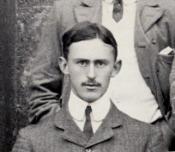
War Memorial
| Captain Richard James PAGET | |
|
B Company, 8th Battalion Canadian Infantry (90th Rifles) Date of birth: 7th March 1884 Date of death: 6th January 1959 Died aged 74 Unknown |

|
| Richard James Paget was born at The Vicarage, Bromsgrove in Worcestershire on the 7th of March 1884 the eldest son of the Reverend Francis Paget, Bishop of Oxford, and Helen Beatrice (nee Church) Paget later of Meadow Lane, Oxford. He was christened at Bromsgrove on the 14th of April 1884. He was educated at Hazelwood School until July 1897 where the school magazine wrote the following when he left: - ".... will carry on, at Shrewsbury, an honoured and distinguished name. He has made his mark here by his enthusiasm for all branches of natural science and his talent for comic acting." He went on to Shrewsbury School from September 1897 to 1902 where he was a member of the Officer Training Corps. In September 1903 he went on to Christ Church Oxford to study medicine where he also served in the Officer Training Corps before leaving in 1904. While at Oxford he joined the Freemasons, where he was initiated as a member of the Apollo University Lodge on the 3rd of May 1904 and was accepted on the 31st of May 1904. He continued his medical studies at the St Bartholomew's Hospital, University of London where he also served in the Officer Training Corps there and, on leaving, practised at Middlesex Hospital. In 1911 he was living at 12 Delamere Terrace, Paddington as a surgical student. He later emigrated to Canada. Following the outbreak of war, he enlisted at Winnipeg in the 90th Rifles on the 9th of August 1914. He travelled to Quebec where he underwent a medical examination at Valcartier Camp in Quebec on the 21st of September 1914 where it was recorded that he was six feet two inches tall and that he weighed 145lbs. It was also recorded that he had clear complexion, brown eyes and brown hair. He was commissioned as a Lieutenant in the 8th Battalion Canadian Infantry (90th Rifles) on the 22nd of September 1914. He sailed for England for training from Quebec on board the SS “Franconia” on the 3rd of October 1914 as part of the first Canadian contingent and enlisted in the 8th Battalion Canadian Infantry (90th Rifles) at Lark Hill Camp on the 9th of January 1915 giving his occupation as a medical student, although he was employed at the time by the Royal Bank of Canada. He embarked for France on the 11th of February 1915 and landed there the next day from where he joined the 8th Battalion Canadian Infantry in the field on the 1st of April 1915 where he was posted to B Company. He was wounded in the right calf by shrapnel on the 25th of April 1915, during the Second Battle of Ypres when the battalion was defending Gravenstafel and was admitted to No. 7 Stationary Hospital at Boulogne on the 26th of April. He was evacuated to England on the 28th of April and was admitted to Miss Pollock’s Hospital at 50 Weymouth Street in London later the same day. A Medical Board sat at Caxton Hall on the 7th of June 1915 to consider his case and decided that he would be unfit for general service for a period of two months. He was declared as being fit for general service at a Medical Board on the 6th of August 1915 and joined the Canadian Training Depot at Shornecliffe on the 15th of August 1915. He returned to France on the 30th of October 1915 where he re-joined his battalion in the field on the 1st of November. He was promoted to temporary Captain on the 11th of November 1915. He was admitted to the 3rd Canadian Field Ambulance on the 20th of January 1916 suffering from trouble with the old wound in his calf and was passed on the 1st Canadian Field Ambulance later the same day. He was admitted to 24 General Hospital at Etaples on the 6th of February 1916. Later that day they wrote the following on his condition: - “Tear of through & through wound at lower end of upper third of R. calf on outer side, fairly superficial but said to have smashed up fibula. Pain in foot, weakness of muscles, especially when walking. Getting worse. Had foot drop for 3 months afterward last April. Sir George Watkins advised sending him home for he considered the condition muscular, as it does not agree with nerve distribution of injury.” He was evacuated back to England on board the Hospital Ship “Stadt Antwerpen” on the 9th of February. He was re-admitted to Miss Pollock’s establishment later the same day where he underwent electrical massage treatment. A report on his condition while he was there read as follows: - “Had bullet wound through calf of right leg, April 25th 1915. Healed satisfactorily but always felt numb and had patch of anaesthesia over foot; he began to complain of weakness of the calf muscle. Came here Feby 9th 1916, left here March 4th considerably improved.” A Medical Board sat at the offices of the Director of Medical Services in London on the 3rd of March 1916 which reported on his condition: - “This officer was wounded by shrapnel on 25th Apr. 1915 as described in Army Form A. 45a (7-6-15). He recovered and went back to B.E.F. but there has been a numbness on outside of right foot and ankle. The peroneal group of muscles have been wasted and considerable pain has been felt in this region. About the last day of January he had to go off duty and eventually reached London, where he had electrical treatment and massage. The condition is improving, but the treatment should be continued whilst he is at his home.” They considered him as being unfit for general service for a period of six weeks and he was discharged from hospital the following day. He was considered as still being unfit for general service a Medical Board which sat at 86 The Strand on the 17th of April 1916 and received a further period of treatment and granted him leave for one month. He was found to be fit for general service at a Medical Board which sat at 86, The Strand in London on the 18th of May 1916. He was attached to the 11th (Reserve) Battalion Canadian Infantry on the 22nd of May 1916 and joined them at their base at Seaford. He was appointed to serve on the Staff of the Headquarters of the Canadian Training Depot on the 21st of February 1917. He proceeded overseas on the 11th of October 1917 where he was attached to 9th Infantry Brigade as a Staff Officer. He went on leave from the 2nd to the 23rd of March 1918. On the 13th of April 1918 he was attached to the Gas Services, Canadian Corps and transferred to 2nd Infantry Brigade as their Gas Officer on the same day. He was attached to 3rd Canadian Division on the 16th of September 1918 and was appointed as Aide de Camp to the General Officer Commanding 3rd Canadian Division on the 19th of September 1918. He went on eight days leave to England on the 6th of January 1919. He travelled to England once more on the 10th of February 1919 and attended the 2nd Discharge Depot on the 6th of March 1919. He left the service the following day. A medical examination, which he underwent at Bramshott on the 11st of March 1919, described his old wound: - “Two small scars at upper and middle third pf right leg, on an anterior outer side, the other on posterior and outer side. Hyper anaesthesia below wound on outer side and in front extending down to R. ankle – Over outer side of dorsum of foot a small patch of anaesthesia. Knee joint normal, ankle joint flexion, extension movement normal. Some weakness at ankle joint. Can walk five miles.” It was also noted that he was suffering from cataracts in both eyes, which had been diagnosed in March 1916 and that his vision became blurred at a distance of twenty feet. After the war he went to work as a yarn agent at 6 Pall Mall, Manchester. He was married to Jean Ross (nee Holden) at Holy Trinity Church, Folkestone on the 29th of September 1915 and she lived at 15 Terlingham Gardens, Folkestone. They had a son, Richard Holden, born on the 25th of April 1920. He left the family home on the 11th of March 1922 and his wife wrote a letter to him on the 8th of April, asking him to return. On the 11th of April, he replied in a letter as follows: - "My dear Jean, In reply to your letter dated April 8th. It is impossible for me to return to you. I say this only after careful thought. We are I think agreed that our marriage, contracted in appalling haste, has proved a most lamentable failure. We are, I think, also agreed, in considering that we are hopelessly incompatible. This being so, it occurs t me much better that we should definitely part. This will, inevitably, cause pain and distress but surely is better than dragging out our loves together, a constant source of irritation to each other. You must therefore take this letter as an absolutely final refusal on my part to return to you. I hope that as a result of this action on my part you may have many happy years ahead of you; a thing that I am afraid would be impossible if we were living together. I hope and think that my decision may not some as a great shock to you. Yours Dick." She filed for divorce on the 26th of April 1922 on the grounds of desertion and was granted a final decree on the 27th of July 1922. He was re-married in 1925 to Eruda Carita (nee Saumier). |
|
| Went on to Shrewsbury School |
Back